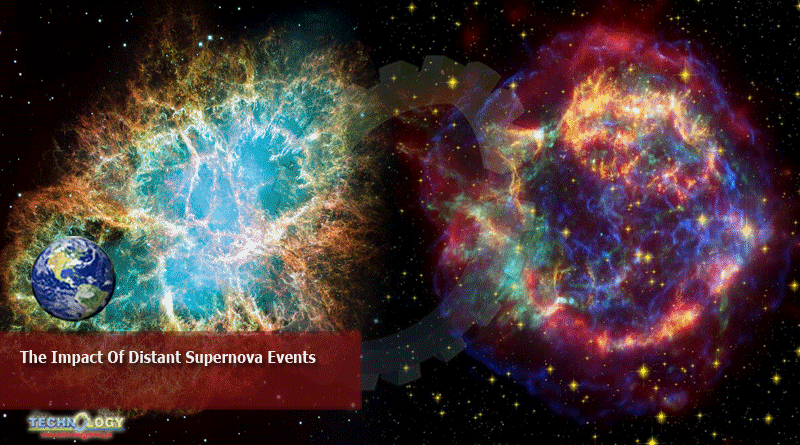A Paper Released This Week By University Of Illinois Urbana-Champaign Astronomy And Physics Professor Brian Fields Makes A Case For Distant Supernova

As a cause of a past mass extinction event—specifically, the Hangenberg event, which marks the boundary between the Devonian and Carboniferous periods. Fields has proposed this sort of thing before, and both this and his earlier piece are fascinating exercises of “what-if.” Each models the effects a supernova could have on Earth’s biosphere, and how we might go looking for evidence that it happened.
Supernova, It’s important to understand, however, that neither of these papers should be taken as indications that there is evidence that the events referenced were caused by a supernova, or as representative of any general scientific consensus to that effect. They’re simply intriguing proposals, and they indicate what sort of evidence we should look for.
Existential threats
If you say “mass extinction” and “space” in the same sentence, the first thing on most peoples’ minds is an asteroid impact with the Earth—even if dinosaur fans think of the Chicxulub crater, and pop culture fans think instead of movies such as Deep Impact or Armageddon.
However, asteroid impact isn’t the only threat the Earth faces from space—and the Cretaceous-Paleogene isn’t the only mass extinction event the Earth has experienced. An even larger mass extinction event occurred 359 million years ago—it’s called the Hangenberg event, which marks the boundary between the Devonian and Carboniferous periods. The Hangenberg event affected both marine and terrestrial biomes, and it wiped out 97 percent of all vertebrate species.
Supernova, An asteroid impact has been advanced as a likely cause of the Kellwasser extinction event, which occurred roughly 10 million years prior. But no major impact has been discovered which dates to the correct period for the Hangenberg event. Several other potential mechanisms have been proposed, including follow-on effects from significant changes in plant life and massive atmospheric injections of carbon dioxide and sulfur dioxide due to magmatism. But so far, there’s no “smoking gun” pointing directly to a cause.
Ozone depletion
What we do know about the Hangenberg extinctions is that they occurred over the course of thousands, and perhaps hundreds of thousands, of years. We also have evidence of ultraviolet damage to pollen and spores over many thousands of years during this event, and that in turn points to a possible long-term destruction of the ozone layer.
The length and severity of this period of ultraviolet damage likely rules out most local causes of ozone layer destruction. Ozone depletion from terrestrial causes, such as increased stratospheric water vapor due to higher surface temperatures, is unlikely to be severe enough to result in the large-scale extinctions seen during this period.
Meanwhile, the ozone layer typically recovers from more local catastrophic astrophysical events—such as bolide impacts, solar flares, and gamma-ray bursts—in ten years or so, which does not account for either the severity or duration of the Hangenberg extinctions.
Fields’ team suggests a supernovae could possibly account for both severity and duration of the Hangenberg extinctions.
The biosphere impact of distant supernovae
Supernova events are popularly imagined as instantaneous—a supermassive star explodes, and a radiation wave front instantly cooks any sufficiently nearby items as it passes. Within 25 light-years or so—far closer than any supernova threats our Solar System faces—this is close enough to accurate.
However, the impact of a supernova event can be felt (and potentially cause extinction events) far outside this relatively narrow “kill radius.” In 2018, another team led by Fields tried to link periods of decreased biological diversity and increased extinction rates 2.5 million years ago—at the Pliocene-Pleistocene boundary—to a likely supernova event. This paper hypothesized a supernova occurring between 163 and 326 light-years away, based on globally elevated levels of Iron-60, a radioactive isotope produced during supernovae. But the extinctions coincided with a period of major climate change, so it’s not clear a supernova would be needed to explain them.
Supernova, For this new work, the team used global climate, atmospheric chemistry, and radiative transfer models to investigate how the flux of cosmic rays from a distant supernova would alter the ozone layer. Thomas told Astrobiology magazine that the impact of a distant supernova doesn’t arrive all at once. Instead, the intergalactic medium slows some particles down more than others, resulting in a “radioactive iron rain” that can last for hundreds of thousands of years.
The key to demonstrating that a supernova occurred in the right time frame to explain the older and more devastating Hangenberg event would be discovery of the radioactive isotopes plutonium-244 and samarium-146 in rocks and fossils deposited during the event. Neither isotope occurs naturally on Earth, and Fields describes them colorfully as “green bananas.”
“When you see green bananas in Illinois,” Fields said, “you know they are fresh, and you know they did not grow here.” The period of decay of Pu-244 and Sm-146 is long enough for detection after 360 million years, but short enough to preclude their inclusion in the Earth’s original formation. Fields goes on to say that discovery of these isotopes today means “they are fresh and not from here—the green bananas of the isotope world—and thus the smoking guns of a nearby supernova.”
This news was originally published at arstechnica.com
